You are here:
Softmirrors.com
> Products > Geophysics Solutions

Geophysics Solutions
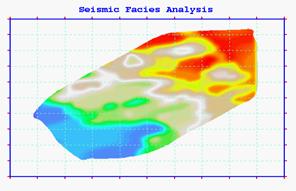 |
seisFacies
When there are few wells available for
reservoir description, the seismic attributes can be used
to study stratigraphic facies. The sliced
attribute/property, which can be generated from our
GeoInversion system, is new
geologic time surface by proportionally slicing between
reference seismic horizons. And the sliced
attribute/property will significantly deepen your
understanding of your stratigraphic facies and your
depositional history of your reservoir. A
self-organization neural network method will be used to
cluster the attributes into several groups which represent
different stratigraphic facies. The existed well facies
will guide the interpretations and evaluations. |
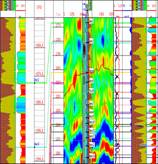 |
Vp/Vs/Den Inversion (seisInversion):
There are two
methods for seismic inversion. The first method is
(non-)Linear Conjugate Gradient method to estimate the Vp,
Vs and density. Another method is Bayesian-based Support
Vector Machine method to incorporate the petrophysical
property and seismic attributes, which has high resolution
with similar to well logs. The Vp/Vs/Den can be used to
calculate the Young's modulus, Poisson Ratio, UCS, Pore
Pressure and minimum horizontal stress, which will be
useful to wellbore stability analysis and shale gas
reservoir evaluation. |
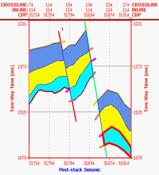 |
Seismic Geological Modeling (seisSuperMan)
An advanced horizon and
fault manipulation tools, including interactive picking of
target horizons and faults. The tool also supports to load
seismic horizons from other system. The target layers,
which build the geological models, compose of top/bottom
horizons and left/right faults. A new technique digitizes
the target layer. The digital layers will guide seismic
attribute extraction and log propagation. After synthetic
seismic, the time-domain logs from vertical and/or
deviated borehole can be inserted into seismic canvas, and
well markers also can be displayed along well logs.
|
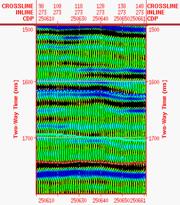 |
AVO/AVA
Attribute
Designed to
extract gradient, intercept and curvature from
pre-stack seismic
gathers. Also when
there are noise gathers, the curved-surface function can
be applied to extract the attributes to consider both the
seismic amplitude-vs.-offset and amplitude-vs.-time.
These AVO attributes can be integrated into other
attributes for geostatistical inversion.
Compressional Velociy, Shear Velocity and Density can be
calculated from AVO angle gathers based on Conjugate
Gradient methods. |
 |
Seismic Time-Frequency Attribute
Designed to decompose post-stack
seismic dataset into time-frequency panel through an
implementation of Match-Pursuit Wigner-Ville Distribution
(WVD). The time-frequency panel will be used to propagate
logs.
|
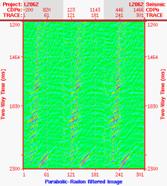 |
Seismic Time-Radon Attribute
Designed to transform pre-stack
seismic gathers into time-radon panel through an
implementation of Parabolic Radon Transform, which also
has been used to de-multiple in seismic processing. The
time-radon panel will keep most of seismic gather
information including amplitude versa offset (AVO).
|
 |
Seismic Time-Velocity Attribute
Designed to transform pre-stack seismic
gathers into time-velocity panel through an implementation
of Fast Hyperbolic Radon Transform, which has been used to
de-multiple in seismic processing. The time-velocity panel
will keep most of seismic gather information including
amplitude versa offset (AVO). A mute window will be
designed to remove multiples and other noises |
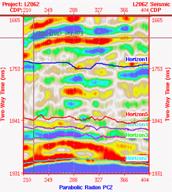 |
Seismic Attribute Analysis
The Factor Analysis will be used to
classify or reduce the attributes from post and/or
pre-stack seismic dataset. Usually Factor Analysis can be
applied in order to explore a content area, structure a
domain, map unknown concepts, classify or reduce data,
transform data, define relationships, etc. R-Factor
Analysis involves factoring variables, which will reduce
attribute space from a larger number of variables to a
smaller number of factors. After R-Factor analysis, the
post-stack attributes and/or pre-stack attributes will be
reduced to produce the HYBRID attributes, which is a
combination of the optimum set of attributes. The HYBRID
attributes have better correlation to well data.
|
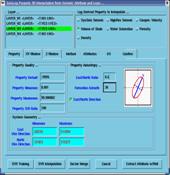 |
Seismic
Anisotropic Advisor (seisSuperMan)
Both seismic survey and well logs are
Cartesian (x, y) coordinate system. However the some
reservoir properties have preferred orientations. To study
the anisotropic effects, the Support Vector Regression
should be performed in the flow-oriented (s,n) coordinate
systems. Usually the anisotropy settings include a ratio
and angle setting. The ratio is the maximum range divided
by the minimum range; the angle ( )
is the orientation (s direction). )
is the orientation (s direction).
|
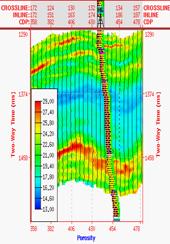 |
Seismic-Guided
Log-Propagated Property (seismic geostatistical
inversion): (seisSuperMan)
Designed to propagate time-domain logs, such as porosity
and water saturation, which utilizes time-frequency
attributes from post-stack, time-velocity and time-radon
attributes from pre-stack seismic. The state-of-the-art
technology, Support Vector Regression (SVR), will be used
to build the bridges between time-domain logs and seismic
hybrid attributes. Anisotropic advisor will support
multi-sector and multi-section analysis for logs
propagation. During SVR mapping phase, the log-propagated
property (named SeisLog) will be generated. The
SeisLog properties, such as porosity, have the same
vertical resolution as time-domain logs and the property
is a better fit with borehole logs.
|
 |
Seismic
Log-Propagated Property (SeisLog) Slice (seisSuperMan)
A
function designed to slice log-propagated property (SeisLog).
The sliced-SeisLog is stratigraphic property and also
shares the same geometry as seismic, which geometry is
irregular. The irregular sliced SeisLog property (IRS-SeisLog)
will be re-scaled and re-interpolated into regular
property for layer-log property mapping.
In addition for layer-log
property mapping, the
sliced
property will significantly deepen your understanding of
your stratigraphic facies and your depositional history of
your reservoir |
|

|
Useful Links:
|